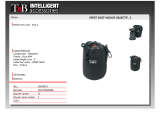
TABLE OF CONTENTS
EATON Power Xpertt 9395 UPS (1000–1100 kVA) Installation and Operation Manual S 164201764 Rev 3 www.eaton.com/powerquality
vi
Figure 5‐1. Powerware Hot Sync CAN Bridge Card 5-1.............................................................
Figure 5‐2. Powerware Hot Sync CAN Bridge Card Connections 5-3....................................................
Figure 5‐3. Distributed Bypass System CAN and Pull-Chain Simplified Interface Wiring 5-5...................................
Figure 5‐4. Distributed Bypass System UPS CAN Wiring without MOBs 5-5..............................................
Figure 5‐5. Distributed Bypass Pull-Chain Wiring without MOBs 5-6...................................................
Figure 5‐6. Distributed Bypass Pull-Chain Wiring with MOBs 5-7......................................................
Figure 5‐7. Remote Monitor Panel II and Relay Interface Module II Terminal Locations 5-10....................................
Figure 5‐8. Remote Monitor Panel II, Relay Interface Module II, or Supervisory Contact Module II Wiring 5-10......................
Figure 5‐9. J1, J2, J3, and J4 15-Pin D-Sub Connectors 5-12..........................................................
Figure 5‐10. Supervisory Contact Module II Terminal Location 5-13.....................................................
Figure 5‐11. Supervisory Contact Module II TB2 5-14...............................................................
Figure 5‐12. Remote Monitor Panel II Dimensions 5-15..............................................................
Figure 5‐13. Relay Interface Module II Dimensions 5-16.............................................................
Figure 5‐14. Supervisory Contact Module II Dimensions 5-17.........................................................
Figure 6‐1. Main Elements of the UPS System 6-1................................................................
Figure 6‐2. Path of Current Through the UPS in Online Mode 6-3......................................................
Figure 6‐3. Path of Current Through the UPS in Bypass Mode 6-6......................................................
Figure 6‐4. Path of Current Through the UPS in Battery Mode 6-7.....................................................
Figure 6‐5. UPS System – Four UPM, Common Rectifier Feed, Common Battery, Dual‐Feed Configuration, Momentary Static Switch 6-9...
Figure 6‐6. UPS System – Four UPM, Common Rectifier Feed, Separate Battery, Dual‐Feed Configuration, Momentary Static Switch 6-10...
Figure 6‐7. UPS System – Three UPM, Common Rectifier Feed, Common Battery, Dual‐Feed Configuration, Momentary Static Switch 6-11..
Figure 6‐8. UPS System – Three UPM, Common Rectifier Feed, Separate Battery, Dual‐Feed Configuration, Momentary Static Switch 6-12..
Figure 6‐9. UPS System – Four UPM, Common Rectifier Feed, Common Battery, Dual‐Feed Configuration, Continuous Static Switch 6-13...
Figure 6‐10. UPS System – Four UPM, Common Rectifier Feed, Separate Battery, Dual‐Feed Configuration, Continuous Static Switch 6-14..
Figure 6‐11. UPS System – Three UPM, Common Rectifier Feed, Common Battery, Dual‐Feed Configuration, Continuous Static Switch 6-15.
Figure 6‐12. UPS System – Three UPM, Common Rectifier Feed, Separate Battery, Dual‐Feed Configuration, Continuous Static Switch 6-16.
Figure 6‐13. UPS System – Four UPM Common Rectifier Feed, Common Battery, IOM Configuration 6-17..........................
Figure 6‐14. UPS System – Four UPM Common Rectifier Feed, Separate Battery, IOM Configuration 6-18..........................
Figure 6‐15. Simplified Dual-Feed UPS with Maintenance Bypass Panel 6-19..............................................
Figure 6‐16. Path of Current through the UPSs in Online Mode – Distributed Bypass 6-22.....................................
Figure 6‐17. Path of Current through the UPSs in Bypass Mode – Distributed Bypass 6-23.....................................
Figure 6‐18. Path of Current through the UPSs in Battery Mode – Distributed Bypass 6-24.....................................
Figure 6‐19. Typical Distributed Bypass System – Momentary Static Switch, 1+1 and 2+0 Configurations 6-26......................
Figure 6‐20. Typical Distributed Bypass System – Momentary Static Switch, 2+1 and 3+0 Configurations 6-27......................
Figure 6‐21. Typical Distributed Bypass System – Momentary Static Switch, 3+1 and 4+0 Configurations 6-28......................
Figure 6‐22. Typical Distributed Bypass System – Continuous Static Switch, 1+1 and 2+0 Configurations 6-29......................
Figure 6‐23. Typical Distributed Bypass System – Continuous Static Switch, 2+1 and 3+0 Configurations 6-30......................
Figure 6‐24. Typical Distributed Bypass System – Continuous Static Switch, 3+1 and 4+0 Configurations 6-31......................
Figure 7‐1. UPS Controls and Indicators 7-1.....................................................................
Figure 7‐2. UPS Control Panel 7-2............................................................................
Figure 7‐3. Parts of the LCD 7-4.............................................................................
Figure 7‐4. Main Menu and Mimic Screen (Online Mode) 7-5........................................................
Figure 7‐5. Load Off Screen 7-9.............................................................................
Figure 7‐6. Typical System Status Screen
7-10...................................................................
Figure 7‐7. REPO Operation 7-28.............................................................................
Figure 8‐1. Optional X-Slot Cards 8-2.........................................................................
Figure 8‐2. Sample Event History Log 8-6.......................................................................
Figure 8‐3. Remote Monitor Panel II Front Panel 8-7...............................................................
Figure 8‐4. Relay Interface Module II Customer Interface Connectors J1 through J4 8-9......................................
Figure 8‐5. Supervisory Contact Module II Enclosure 8-10............................................................
Figure 9‐1. ISBM Section Air Filter Locations – Momentary Static Switch 9-3.............................................





















